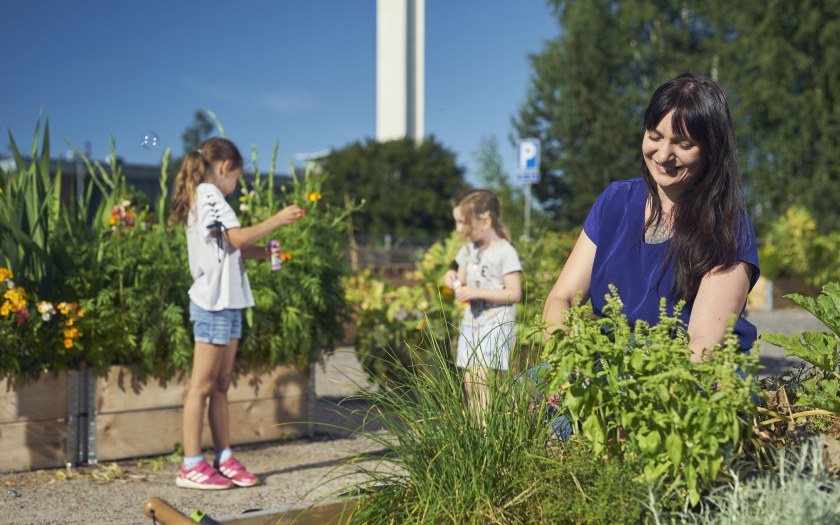The Kera district under construction in Espoo is setting a new sustainable smart city standard. At the same time, Kera exemplifies how companies, research organisations, land owners and other development partners, the City of Espoo and citizens work together to put Espoo's sustainable development program into action.
Kera is a traditional industrial area in Espoo that is becoming an international sustainable smart city and circular economy showcase. The 14 000 people and the companies that will make Kera their home in the 2020s will enjoy exceptional services and quality of living. A 5G urban network built by Nokia — the global 5G leader headquartered in Kera — enables the use of advanced circular economy, mobility, and IoT solutions in the urban environment.
Among the various projects happening in Kera, the two most prominent ones are the Nokia-led LuxTurrim5G ecosystem and the Smart and Clean Kera project. LuxTurrim5G develops the digital, data-driven platform for smart city purposes. Meanwhile, Smart and Clean Kera creates, for example, the energy, built environment, and circular energy infrastructure in the area. In addition to the City of Espoo, big Finnish corporations such as the sustainability leader Neste, the energy company Fortum, and SOK Corporation are involved in the area’s development.
Sustainability and co-creation go hand in hand in all phases of Kera's development. Companies can already pilot their solutions in the area and cooperate with Aalto University and VTT that provide the latest scientific research.
"In Kera, carbon neutrality is being advanced in practice. Kera is a tool and a testbed through which the companies can develop their clean and smart solutions. Cross-cutting themes for all development in the area are the base for all development," explains Emmi Kauhanen, Development Manager, City of Espoo.
For example, the self-driving technology startup Sensible 4 has piloted its autonomous shuttle bus on the Kera streets. Meanwhile, in the digital space made possible by the piloting environment's digital twin, Aalto University Design Factory finished a wide-ranging smart urban furniture project regarding smart pole and other infrastructure elements. Using VR tools, the project embedded the smart urban furniture in the virtual city space of Kera.
"We aim to find common objectives that advance sustainable development in discussion with partners. The targets are defined together, and we pursue them through co-development," Kauhanen explains.

A testbed for practical smart city solutions
Nokia has established the LuxTurrim 5G development in Kera's ecosystem. LuxTurrim5G is a super-fast 5G network of smart poles with integrated antennas, base stations, sensors, displays and other devices that make real smart cities possible.
Currently, Kera's 5G network comprises 19 smart poles with different sensors, cameras and functionalities. The pilot environment also has two smart bus stops, uses drones and self-driving vehicles, and connects a millimetre wave 5G along with a rich sensor network with more than 250 connected IoT devices. On top of all this, and most importantly, the data platform is secure — which is the absolute requirement in creating data-driven services for citizen's actual needs.
"Kera is a tool and a testbed through which the companies can develop their clean and smart solutions."
The digital platform, however, is only one of the development projects in Kera. Ground-breaking work is also happening in other city development sectors — done together with partners: renewable energy application, mobility, ethical data management, architecture and living environments, and more.
Espoo is the enabler of sustainable development in the community
The Kera district showcases how Espoo is on the path to reach the UN's sustainable development goals by 2025 and carbon neutrality already by 2030. And the role and well-being of the citizens are always ingrained in the implementation of these ambitious goals.
"The voice of the citizens needs to be heard. Citizens' participation and engagement are vital for the project's success."
The 6Aika Kieppi circular economy project is one of Espoo's concrete sustainability efforts that improve people's quality of life in Kera. Kieppi has three development themes in Espoo: spaces and sharing economy services; utilisation of material, nutrient and energy streams; and urban food production. Naturally, new circular economy solutions are planned and implemented together with companies, and the future residents are engaged early on in the project.
"The voice of the citizens and people that will use the area needs to be heard. Citizens' participation and engagement are vital for the creation of sustainable districts. To enable this, we're setting up Kera Hub, which is an event and meeting space for the people and operators in the area," Kauhanen says.
In addition to the Kera project, co-creation powers many of the city's several testbed projects. For Kauhanen, these projects exemplify what makes Espoo a leading city in sustainability now and in the future: co-creation, world-class research, and the quality of sustainable startups, companies, and innovations.
Hero image: The City of Espoo
Do sustainable business and land in Espoo
Enter Espoo helps you to do sustainable business and to find office spaces in Espoo’s innovation ecosystem.



